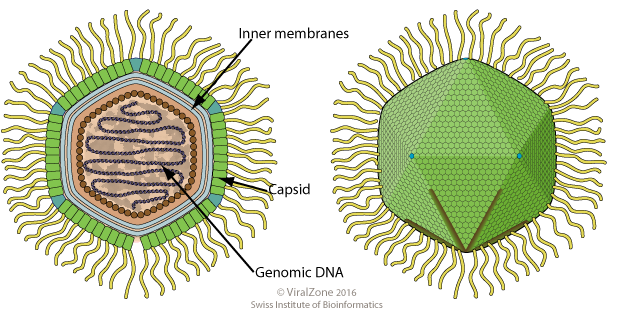|
Pimascovirales
''Pimascovirales'' is an order of viruses. The term is a portmanteau of a portmanteau of pitho-, irido-, marseille-, and ascoviruses. Families The following families are recognized: * ''Ascoviridae'' * ''Iridoviridae'' * ''Marseilleviridae ''Marseilleviridae'' is a family of viruses first named in 2012. The genomes of these viruses are double-stranded DNA. Amoeba are often hosts, but there is evidence that they are found in humans as well. The family contains one genus and four ...'' References Viruses {{Virus-stub ... [...More Info...] [...Related Items...] OR: [Wikipedia] [Google] [Baidu] |
Virus
A virus is a submicroscopic infectious agent that replicates only inside the living cells of an organism. Viruses infect all life forms, from animals and plants to microorganisms, including bacteria and archaea. Since Dmitri Ivanovsky's 1892 article describing a non-bacterial pathogen infecting tobacco plants and the discovery of the tobacco mosaic virus by Martinus Beijerinck in 1898,Dimmock p. 4 more than 9,000 virus species have been described in detail of the millions of types of viruses in the environment. Viruses are found in almost every ecosystem on Earth and are the most numerous type of biological entity. The study of viruses is known as virology, a subspeciality of microbiology. When infected, a host cell is often forced to rapidly produce thousands of copies of the original virus. When not inside an infected cell or in the process of infecting a cell, viruses exist in the form of independent particles, or ''virions'', consisting of (i) the genetic material, i. ... [...More Info...] [...Related Items...] OR: [Wikipedia] [Google] [Baidu] |
Pithovirus
''Pithovirus'', first described in a 2014 paper, is a genus of giant virus known from two species, ''Pithovirus sibericum'', which infects amoebas and ''Pithovirus massiliensis''. It is a double-stranded DNA virus, and is a member of the nucleocytoplasmic large DNA viruses clade. The 2014 discovery was made when a viable specimen was found in a 30,000-year-old ice core harvested from permafrost in Siberia, Russia. Description The genus name ''Pithovirus'', a reference to large storage containers of ancient Greece known as pithoi, was chosen to describe the new species. A specimen of ''Pithovirus'' measures approximately 1.5 μm (1500 nm) in length and 0.5 μm (500 nm) in diameter, making it the largest virus yet found. It is 50% larger in size than the ''Pandoraviridae'', the previous largest-known viruses, and is larger than '' Ostreococcus'', the smallest eukaryotic cell, although ''Pandoravirus'' has the largest viral genome, containing 1.9 to 2.5 megabases ... [...More Info...] [...Related Items...] OR: [Wikipedia] [Google] [Baidu] |
Ascoviridae
''Ascoviridae'' is a family of double strand DNA viruses that infect primarily invertebrates, mainly noctuids and spodoptera species; it contains two genera, ''Ascovirus'', which contains three species, and ''Toursvirus'' with a single species ''Diadromus pulchellus toursvirus''. Taxonomy The family contains the following genera and species: * '' Ascovirus'' ** '' Heliothis virescens ascovirus 3a'' ** '' Spodoptera frugiperda ascovirus 1a'' ** '' Trichoplusia ni ascovirus 2a'' * '' Toursvirus'' ** ''Diadromus pulchellus toursvirus'' Genome The genome is not segmented and contains a single molecule of circular double-stranded DNA. The genome has a guanine + cytosine content of 42-60%. The genome of Spodoptera frugiperda ascovirus 1a has been sequenced. It is 156,922 bases in length and encodes 123 putative open reading frames. The G+C ratio is 49.2%. Among the encoded proteins are a caspase, a cathepsin B, several kinases, E3 ubiquitin ligases, a fatty acid elongase, a sphin ... [...More Info...] [...Related Items...] OR: [Wikipedia] [Google] [Baidu] |
Iridoviridae
''Iridoviridae'' is a family of viruses with double-stranded DNA genomes. Amphibians, fish, and invertebrates such as arthropods serve as natural hosts. There are currently 22 species in this family, divided among two subfamilies and seven genera. Nomenclature The name is derived from Iris, the Greek goddess of the rainbow. This name was chosen because of the "rainbow-like" iridescence observed in heavily infected insects and pelleted samples of invertebrate iridoviruses. It may refer to any member of the ''Iridoviridae'' family or a particular genus within ''Iridoviridae''. Taxonomy The following subfamilies and genera are recognized (-''virinae'' denotes subfamily and -''virus'' denotes genus): * '' Alphairdovirinae'' ** ''Lymphocystivirus'' ** ''Megalocytivirus'' ** ''Ranavirus'' * ''Betairidovirinae'' ** ''Chloriridovirus'' ** '' Daphniairidovirus'' ** '' Decapodiridovirus'' ** ''Iridovirus'' Structure The virions are icosahedral with triangulation number (T) = 189–217, ... [...More Info...] [...Related Items...] OR: [Wikipedia] [Google] [Baidu] |
Marseilleviridae
''Marseilleviridae'' is a family of viruses first named in 2012. The genomes of these viruses are double-stranded DNA. Amoeba are often hosts, but there is evidence that they are found in humans as well. The family contains one genus and four species, two of which are unassigned to a genus. It is a member of the nucleocytoplasmic large DNA viruses ''Nucleocytoviricota'' is a phylum of viruses. Members of the phylum are also known as the nucleocytoplasmic large DNA viruses (NCLDV), which serves as the basis of the name of the phylum with the suffix - for virus phylum. These viruses are refe ... clade. Taxonomy The genus contains the following genera and species: *'' Marseillevirus'' **'' Marseillevirus marseillevirus'' **'' Senegalvirus marseillevirus'' *Species unassigned to a genus: **'' Lausannevirus'' **'' Tunisvirus'' Related Viruses Additional species have since been recognized. The first member of this family recognized has been named ''Acanthamoeba polyphaga marse ... [...More Info...] [...Related Items...] OR: [Wikipedia] [Google] [Baidu] |
